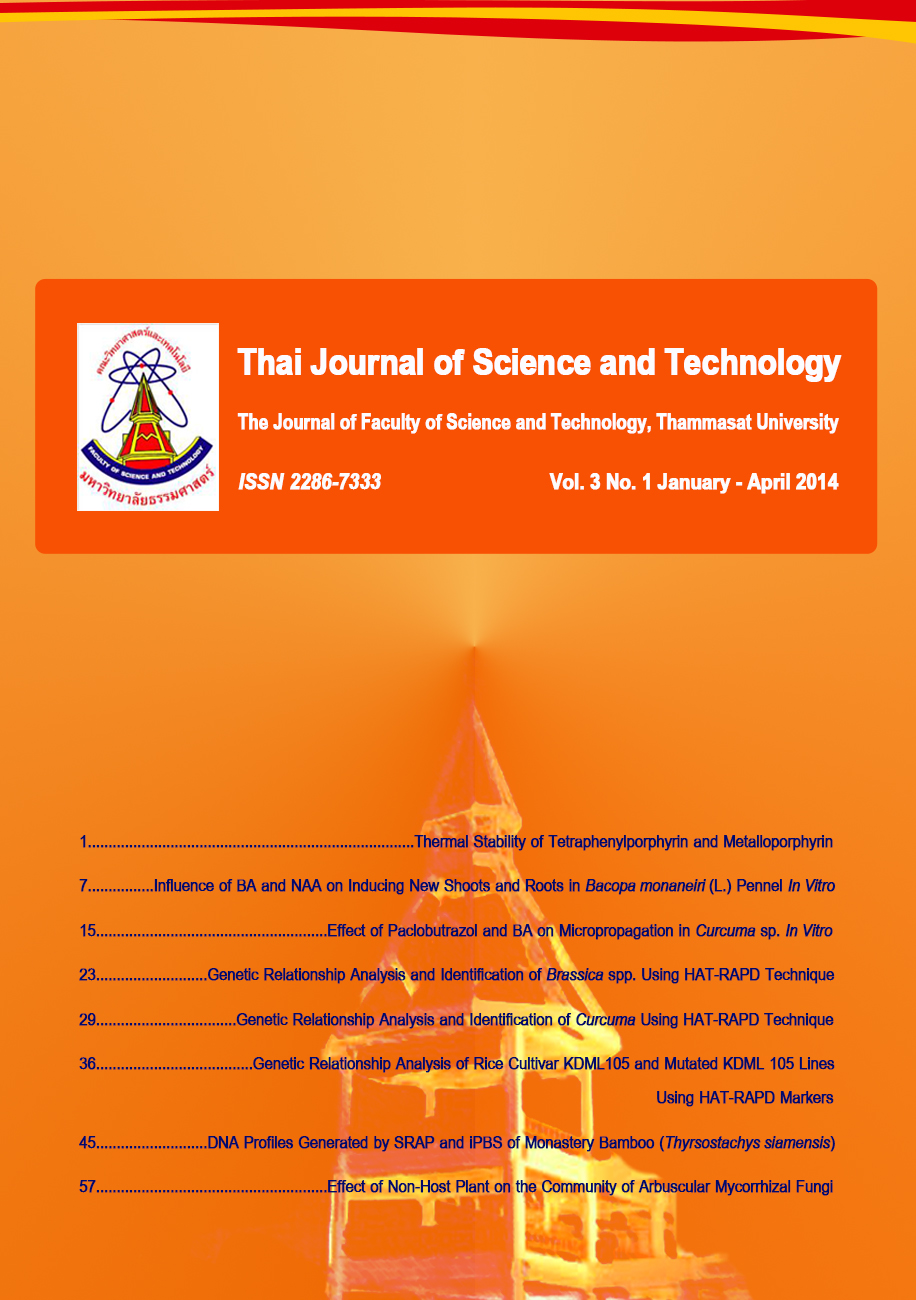ผลของสารพาโคลบิวทราโซลร่วมกับ BA ในการขยายพันธุ์ปทุมมา (Curcuma sp.) โดยการเพาะเลี้ยงเนื้อเยื่อ
Main Article Content
Abstract
บทคัดย่อ
ช่อดอกอ่อนปทุมมาขนาด 0.5 เซนติเมตร เพาะเลี้ยงบนอาหารสังเคราะห์สูตร Murashige & Skoog (1962) ที่ความเข้มข้นเต็มสูตร (full strength, MS) และครึ่งสูตร (half strength, ½ MS) ร่วมกับ NAA เข้มข้น 0.5 mg/l และ BA เข้มข้น 0.5 mg/l พบว่าอาหารสูตร MS ทั้งสองความเข้มข้นให้ผลเหมือนกัน มีจำนวนหน่อแตกขึ้นมาใหม่สูงสุด ส่วนการทดลองเติมสารพาโคลบิวทราโซล (สารชลอการเจริญเติบโต) ที่ความเข้มข้น ต่าง ๆ (0, 0.01, 0.1, 1.0, 5.0 และ 10 mg/l) ร่วมกับน้ำตาลซูโครสขนาด 2, 4 และ 6 % เมื่อทำการวิเคราะห์ผลที่ได้ทางกายภาพ 5 ลักษณะ ทางสถิติ พบว่าแต่ละลักษณะมีความแตกต่างกันทางสถิติอย่างมีนัยสำคัญ (p < 0.05) คือ สารพาโคลบิวทราโซลมีผลทำให้การเจริญเติบโตลักษณะต่าง ๆ ลดลง โดยเฉพาะความยาวเฉลี่ยของก้านใบในสูตรเติมสารพาโคลบิวทราโซลอย่างเดียวจะสั้นกว่าสูตรอื่น ๆ ทั้งนี้ขึ้นอยู่กับความเข้มข้นของสารพาโคลบิวทราโซลที่เติมลงไป
คำสำคัญ :
ปทุมมา; พาโคลบิวทราโซล; น้ำตาลซูโครส
Abstract
Young inflorescences about 0.5 cm tip of Curcuma sp. cultured on half and full strength of Murashige & Skoog medium (1962) and supplemented with different concentration of NAA and BA. It was showed that both ½ MS and MS medium supplemented with 0.5 mg/l NAA and 0.5 mg/l BA gave the highest average new shoots. MS medium supplemented with different concentration (0, 0.01, 0.1, 1.0, 5.0 and 10 mg/l) of pacolbutrazol, and 2, 4 and 6 % sucrose. The result showed that characteristics of 5 parameters was significant different (p < 0.05). Pacolbutrazol was reduced growth of each parameters in Curcuma sp. especially average of leaf petriole length was shortest when MS medium supplemented with pacolbutrazol. This depends on concentration of pacolbutrazol in MS medium.
Keywords:
Curcuma sp.; paclobutrazol; sucrose
Article Details
บทความที่ได้รับการตีพิมพ์เป็นลิขสิทธิ์ของคณะวิทยาศาสตร์และเทคโนโลยี มหาวิทยาลัยธรรมศาสตร์ ข้อความที่ปรากฏในแต่ละเรื่องของวารสารเล่มนี้เป็นเพียงความเห็นส่วนตัวของผู้เขียน ไม่มีความเกี่ยวข้องกับคณะวิทยาศาสตร์และเทคโนโลยี หรือคณาจารย์ท่านอื่นในมหาวิทยาลัยธรรมศาสตร์ ผู้เขียนต้องยืนยันว่าความรับผิดชอบต่อทุกข้อความที่นำเสนอไว้ในบทความของตน หากมีข้อผิดพลาดหรือความไม่ถูกต้องใด ๆ


